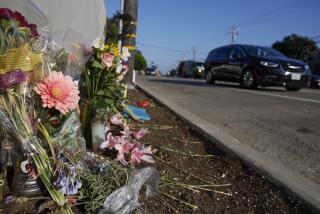Safety Study Broadsides Boomtown
- Share via
PEMBROKE PINES, Fla. — Reached on his car phone for comment, the mayor was sarcastic. “I’m now at Pines and Flamingo,” Alex G. Fekete joked. “I’m waiting for an accident to happen.”
Until this summer, if Pembroke Pines had any fame, it was as one of the fastest-growing cities in the United States, a pleasant municipality of planned and gated communities, numerous parks and plentiful shopping.
In the ‘90s, enough new people piled in here to double the population, to 138,000. Old-timers--that is, anybody who has lived in Pembroke Pines for a generation or so--can recall when they were surrounded mostly by cow pastures and stands of live oak. Now this bedroom community northwest of Miami has been awarded another distinction: Car Crash Capital, USA.
A recent study by the State Farm Mutual Automobile Insurance Co. identified the shopping mall-rich crossroads of Pines Boulevard and Flamingo Road as America’s most dangerous, based on insurance claims. In 1999-2000, State Farm calculated, the intersection was the site of 357 accidents.
And the mayor and other residents don’t think they merit it.
“Can you fathom that Pembroke Pines has the most dangerous intersection in this country, more dangerous than anything in New York, Los Angeles, Chicago?” Fekete asked incredulously over the phone. “I can’t fathom it.”
The study has become the talk of the town and landed Pembroke Pines an unwelcome spot on the front pages of Florida’s newspapers. Last week, TV news crews drove here from Miami and Fort Lauderdale, hoping to film wrecks as they happened. They went home disappointed, Police Capt. Keith Palant said.
“We’ve checked on that intersection, and we haven’t had a traffic fatality there in eight or nine years,” Palant said. “And the one we did have was a newspaper vendor who was hit and killed by a drunk driver. I travel that intersection twice a day, and on average four times a week with my family, and I don’t ever recall seeing an accident there, with the exception of that fatality I spoke about.”
“We see plenty of accidents out there, but not to the point where I’d think it’d be No. 1,” said Noel Silva, district manager for the Men’s Wearhouse, whose store is near the corner. “Since the news came out, we’ve seen an increase in police out there, especially in the mornings.”
What’s not in dispute is that Pines and Flamingo is very busy, a byproduct of Pembroke Pines’ population boom and a lag in building and improving roads to keep pace. According to the mayor, 165,000 cars cross the intersection on any given day. For a decade, the town has been lobbying the state to have another east-west thoroughfare approved and paved to take some of the load off Pines Boulevard--to no avail.
Plans for an overpass to improve traffic flow and safety at Pines and Flamingo were shot down by local merchants worried about the loss of business.
The intersection is one of Florida’s most sprawling, with six lanes entering from each direction. Shopping malls sit on three corners, including Pembroke Lakes Mall, one of the state’s biggest, which draws 55,000 shoppers on a typical day.
Another predictable Florida factor in the mix is senior citizens: A Century Village retirement community near Pines and Flamingo is home to 10,000 older folks.
“Their motor skills may not be what they used to be,” Fekete said. “It’s just a fact of life.”
Police say they often ticket drivers at the intersection for going straight from a right-hand turn lane or running red lights. John Nepomuceno, a State Farm traffic engineer who took part in the study, found most accidents at the intersection were rear-end crashes. He suggested more signals for right-hand turns and markings on the pavement to guide drivers making left turns.
Where State Farm and officials in Pembroke Pines part ways is methodology. Town officials complain that the insurance company counted accidents at the entrances and exits to shopping malls and up to 500 feet from the actual intersection. Dick Luedke, public affairs specialist at State Farm headquarters in Bloomington, Ill., said accidents were counted only if the intersection was deemed a factor.
“Intersections are inherently dangerous in that you’ve got cars coming from four different directions,” Luedke said. “If traffic is backed up and somebody is leaving the exit of a parking lot and trying to negotiate a left turn, it’s pretty challenging and definitely related to the intersection.”
In compiling its list, State Farm, which insures about 21% of Florida’s drivers, studied the claims of its policyholders, gave each a score according to the severity of their accidents and revised the figures to take into account those motorists who were insured by other companies.
The silver lining for the city is that State Farm is ready to pay as much as $20,000 for a study of how to improve each of the 10 most dangerous intersections, and as much as $100,000 for the actual work.
“It’s a public relations exercise for them,” Fekete said. “But I welcome their money to make improvements.”
More to Read
Sign up for Essential California
The most important California stories and recommendations in your inbox every morning.
You may occasionally receive promotional content from the Los Angeles Times.













